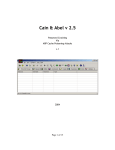Download Nixie Clock Marcel User Manual for on
Transcript
Nixie Clock Marcel User Manual May 2011 Safety Precautions Do not power on the clock when tubes are damaged or missing. Use the power supply that came with the clock, or use a power supply that's compliant with the technical specifications of the clock. Do not expose the clock to rain or moisture. Do not put the clock in sunlight for a long time. Do not expose the clock to high temperatures. Do not cover the clock. Always clean the clock with a dry or very slighty damp cloth. Do not use any detergents. Be careful while touching the tubes, esp. the nozzle at the top. Power off the clock before cleaning. The clock must be completely dry when it's powered on. Do not subject the clock to mechanical shocks. Avoid any mechanical shocks to the tubes and to the top of the tubes in particular. Keep out of reach of children. Technical Information Power supply 12 VDC, 500 mA Power consumption 3 W max. DC-connector Dimensions 138 mm x 63 mm x 68 mm (W x D x H) Nixie Tubes IN-16 Background light Depends on the clock's configuration: ▪ Cyan LEDs ▪ Ocean green LEDs ▪ RGB LEDs with automatically changing colors Time format ▪ 12 hour format ▪ 24 hour format Date format ▪ DD-MM-YY (day-month-year) ▪ MM-DD-YY (month-day-year) Alarm snooze time 1..9 minutes Backup power 30 minutes Durability Tubes ▪ Tube life saving mode with adjustable brightness (to prevent wearing out) ▪ Periodical animations (to prevent cathode poisioning) 2 User Manual Installation Connect the DC plug of the power supply to the DC connector on the back of the clock. Plug the power supply into a power socket. The clock is now powered on. Please note there's no ON/OFF switch. To power off the clock remove the power supply from the power socket and/or disconnect the DC connector from the clock. After you've powered on the clock, the clock will show the display mode. When you power off the clock, the clock will remember all settings for approximately 30 minutes. All settings will be lost thereafter, meaning you'll have to set up again after powering on the clock. Control Panel Turn the knob LED to control the brightness of the background lightning. The brightness varies from no light at all to maximal intensity. The meaning of the buttons MODE/OPTION, SET/ALARM and ADJ/SNOOZE depends on the clock's current mode. You can operate the buttons MODE/OPTION and SET/ALARM in two ways: ▪ Push briefly: Push the button and release immediately. This operation is called pushing the button. ▪ Hold: Push the button for at least one second and release afterwards. This operation is called holding the button. User Manual 3 Display Mode Push MODE/OPTION to show time, alarm and date. Push SET/ALARM to turn on or off the alarm. An orange dot in the right tube indicates whether the alarm is turned on. When the alarm goes off push SET/ALARM to stop the alarm. Push ADJ/SNOOZE to show the current date for a number of seconds. When the alarm goes off push ADJ/SNOOZE to snooze. The alarm will go off again after the snooze time has expired. Hold MODE/OPTION to activate the option mode. Hold SET/ALARM to activate the setup mode. Setup Mode Setup mode allows you to set the time, the alarm and the date. Push MODE/OPTION to cycle through the various settings: time ► alarm ► date ► back to display mode Push SET/ALARM to step through the various values of a setting. The currently selected value flashes. Push ADJ/SNOOZE to change the value. Time hours minutes Alarm seconds hours minutes snooze Snooze time is expressed in minutes Date Date format DD-MM-YY day 4 month year Date format MM-DD-YY month day year User Manual Option Mode Option mode allows you to change various settings of the clock. Press MODE/OPTION to step through the available options. The value of the currently selected option flashes. Push ADJ/SNOOZE to change the value. The clock will revert to display mode when you don't push any button for at least fifteen seconds. Time Format option Date Format value ▪ 12: 12 hour format ▪ 24: 24 hour format Leading Zero option ▪ 0: Disabled ▪ 1: Enabled Digit Cross Fading option option ▪ 1: DD-MM-YY (day-month-year) ▪ 2: MM-DD-YY (month-day-year) Display Date option Automatically show date: ▪ 0: Disabled ▪ 1: At 00/10/20/30/40/50 sec. ▪ 2: At 00/20/40 seconds ▪ 3: At 00/30 seconds ▪ 4: At 40 seconds ▪ 5: At 50 seconds ▪ 6: At the top of the hour ▪ 7: At midnight Date Scrolling Speed Digit cross fading in the tubes: ▪ 0: Disabled ▪ 1..9: Fast (1) to slow (9) option ▪ 1..4: Fast (1) to slow (4) User Manual 5 Tubes Animation Method option option ▪ ▪ ▪ ▪ ▪ ▪ 0: 1: 2: 3: 4: 5: No animation Cycling digits Waving digits Cycling digits Cycling digits Cycling digits Alarm Tone every minute every minute every 10 min. every hour at midnight ▪ 1..9: Fast to slow pace ▪ 10: No alarm tone Brightness of Tube Saving Mode Cycling Digits option ▪ 0: Off ▪ 1..10: Minimal to maximal option ▪ ▪ ▪ ▪ 1: 2: 3: 4: Left to right Right to left All tubes at once Random Start of Tube Saving Mode Brightness option ▪ 00..23: Midnight to 23 hours Duration of Tube Saving Mode option ▪ 1..10: Minimal to maximal Clock's Precision option ▪ 00: No saving mode ▪ 01..23: Active hours ▪ 24: Saving mode always active option Press SET/ALARM to increment the value by one. Press ADJ/SNOOZE to decrement the value by one. 6 User Manual Adjusting the Clock's Precision Option 10 in the option mode allows you to adjust the clock's precision. If you decrease the value by one, the clock runs approx. 1.3 s slower per month. If you increase the value by one, the clock runs approx. 1.3 s faster per month. In order to adjust the clock's precision you have to determine how much time the clock deviates over a period of time. Use a reference clock to this purpose. Examples of a reference clock include a GPS clock and the clock on the Teletext pages. Measure the period in hours and the deviation in seconds. The deviation is positive when the clock runs too fast, it is negative when the clock runs too slow. When you determine the deviation, you must only take whole seconds into account disregarding any fractional part. Once you've determined the values for the period and the deviation, use the following formula to calculate the adjustment: adjustment = − (deviation × 550 ÷ period) Example Suppose the clock runs 2 seconds behind over a period of 72 hours. Hence the deviation is -2 s. According to the formula, the adjustment is −(−2 × 550 ÷ 72) = ~15. In order to adjust the clock's precision, you'll have to add 15 to the value of option 10 in the option mode. Contact Information Official website: http://www.axiris.be/ User Manual 7



















